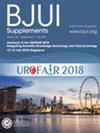造影剂增强程度提高了根治性肾切除术后新的基线肾小球滤过率的预测。
IF 3.7
2区 医学
Q1 UROLOGY & NEPHROLOGY
引用次数: 0
摘要
目的:评估PVA+(一种结合差分增强度(DOE)和实质体积分析(PVA)的模型)预测根治性肾切除术(RN)后新的基线肾小球滤过率(NBGFR)的准确性,并评估肾积水患者中PVA+与单独PVA的对比,其中实质体积/功能关系的破坏可能影响预测准确性。患者和方法共纳入485例术前行对比增强计算机断层扫描的RN患者(2006-2021)。预测NBGFR估计为1.25 (GFRpreRN x对侧分裂肾功能[SRF]), 1.25代表成人RN后的平均肾功能代偿。对于PVA, SRF是通过差异实质体积来确定的,而对于PVA+,差异DOE也被纳入。使用半自动软件从静脉相和非对比图像中测量实质体积和DOE。预测和观察的NBGFR的准确性使用15%的阈值进行比较。结果总体而言,PVA+预测NBGFR的准确率为76% (r = 0.86),而PVA单独预测NBGFR的准确率为72% (r = 0.84,均P < 0.05)。PVA+在肾积水或肾静脉血栓形成(RVT;PVA+和单独PVA的准确率分别为68%和50%;p < 0.01)。同样,在浸润性肾肿块(IRMs)患者中,PVA+优于PVA单独治疗(55% vs 40%;p < 0.01)。结论准确预测肾移植后NBGFR对考虑行肾移植与部分肾切除术的患者进行咨询至关重要。PVA+预测NBGFR优于单独PVA,特别是在肾积水、RVT和irm患者中。PVA+仅需要常规术前增强成像,可改善局部肾肿块患者的围手术期决策,特别是在实质体积/功能关系可能扭曲的情况下。本文章由计算机程序翻译,如有差异,请以英文原文为准。
Degree of contrast enhancement improves prediction of new baseline glomerular filtration rate following radical nephrectomy.
OBJECTIVES
To assess the accuracy of PVA+, a model integrating differential degree of enhancement (DOE) with parenchymal volume analysis (PVA), for predicting new baseline glomerular filtration rate (NBGFR) following radical nephrectomy (RN), and to assess PVA+ vs PVA alone in patients with hydronephrosis, where disruptions in the parenchymal volume/function relationship may impact prediction accuracy.
PATIENTS AND METHODS
A total of 485 RN patients (2006-2021) with preoperative contrast-enhanced computed tomography were included. The predicted NBGFR was estimated to be 1.25 (GFRpreRN x split renal function [SRF]contralateral), with 1.25 representing the average renal functional compensation following RN in adults. For PVA, SRF was determined with differential parenchymal volumes, whereas for PVA+ the differential DOE was also incorporated. Parenchymal volumes and DOE were measured using semi-automated software from the venous phase vs non-contrast images. The accuracy of predicted vs observed NBGFR was compared using a 15% threshold.
RESULTS
Overall, PVA+ accurately predicted NBGFR for 76% (r = 0.86) of the cases, compared to 72% for PVA alone (r = 0.84, both P < 0.05). PVA+ was particularly advantageous in patients with hydronephrosis or renal vein thrombosis (RVT; 68% vs 50% accuracy for PVA+ vs PVA alone; P < 0.01). Similarly, PVA+ was superior in patients with infiltrative renal masses (IRMs) compared to PVA alone (55% vs 40%; P < 0.01).
CONCLUSION
Accurate prediction of NBGFR following RN is essential for counselling patients for whom RN is being considered vs partial nephrectomy. PVA+ was superior to PVA alone for NBGFR prediction, particularly in patients with hydronephrosis, RVT and IRMs. Requiring only routine contrast-enhanced preoperative imaging, PVA+ improves peri-operative decision-making for patients with localised renal masses, particularly in cases where the parenchymal volume/function relationship might be distorted.
求助全文
通过发布文献求助,成功后即可免费获取论文全文。
去求助
来源期刊

BJU International
医学-泌尿学与肾脏学
CiteScore
9.10
自引率
4.40%
发文量
262
审稿时长
1 months
期刊介绍:
BJUI is one of the most highly respected medical journals in the world, with a truly international range of published papers and appeal. Every issue gives invaluable practical information in the form of original articles, reviews, comments, surgical education articles, and translational science articles in the field of urology. BJUI employs topical sections, and is in full colour, making it easier to browse or search for something specific.
 求助内容:
求助内容: 应助结果提醒方式:
应助结果提醒方式:


